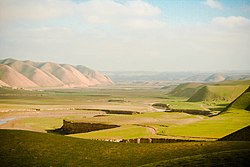Faryab Province
|
Faryab فاریاب |
|
|---|---|
| Province | |

Mountains and River in Faryab province
|
|
 Map of Afghanistan with Faryab highlighted |
|
| Coordinates (Capital): 36°15′N 64°50′E / 36.250°N 64.833°ECoordinates: 36°15′N 64°50′E / 36.250°N 64.833°E | |
| Country |
|
| Capital | Maymana |
| Government | |
| • Governor | Sayed Anwar Sadat |
| Area | |
| • Total | 20,797.6 km2 (8,030.0 sq mi) |
| Population (2012) | |
| • Total | 948,000 |
| • Density | 46/km2 (120/sq mi) |
| Time zone | UTC+4:30 |
| ISO 3166 code | AF-FYB |
| Main languages | Dari (Persian) |
Faryab (Persian: فاریاب) is one of the thirty-four provinces of Afghanistan, which is located in the north of the country bordering neighboring Turkmenistan. It has a population of about 948,000, which is multi-ethnic and mostly a tribal society. The province encompasses 15 districts and over 1,000 villages. The capital of Faryab province is Maymana.
Faryab is a Persian toponym meaning "lands irrigated by diversion of river water". It is named after a town that was founded by the Sassanids and later destroyed by the invading Mongols in 1220. It is the hometown to the famed Islamic philosopher, al-Farabi, per the biographer Ibn al-Nadim. The area has been part of Greater Khorasan. British geographers referred to the area as Afghan Turkestan.
The history of settlement in Faryab is ancient and comprises layer upon layer of occupation. At times, it was a melting pot within which a host of cultures have merged into a non-conflictual whole or at least peaceable coexistence. Maymana (the small capital city of the district) and Andkhui actually entered written history 2,500 years ago when Jews arrived and settled in 586 BC, fleeing the destruction of Jerusalem by Nebuchadnezzar. The territory was under Persian control at the time, which later gave way to Greek rule following the conquest by Alexander the Great in 326 BC. Persian dominance was restored from the 3rd to the 7th century AD.
The pre-Islamic period ended with the conquest of northern Afghanistan by Arab Muslims (651-661 AD). The area "turned into a vast battlefield as the two great Arab and Persian cultures battled for not only political and geographical supremacy but ideological supremacy." As a result, centuries of Zoroastrianism, Buddhism, Nestorian Christianity and indigenous pagan cults were swept away. Various Islamic dynasties rose to power and influenced the locals. They included the Saffarids, Samanids, Ghaznavids, Seljuks, and Ghurids.
...
Wikipedia
